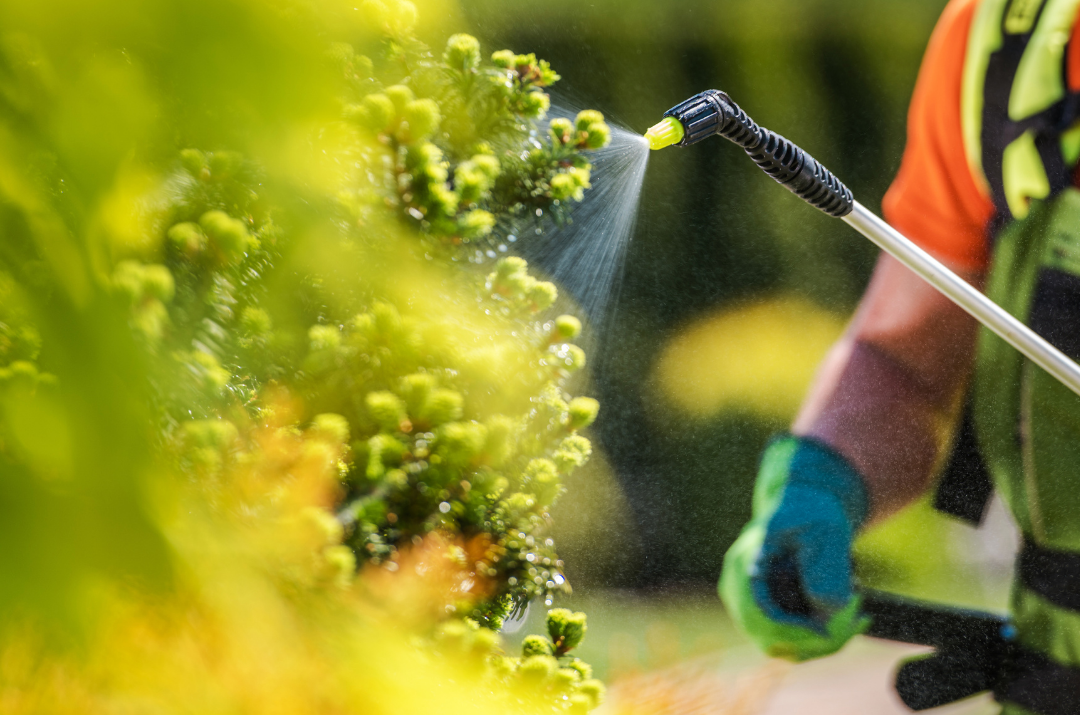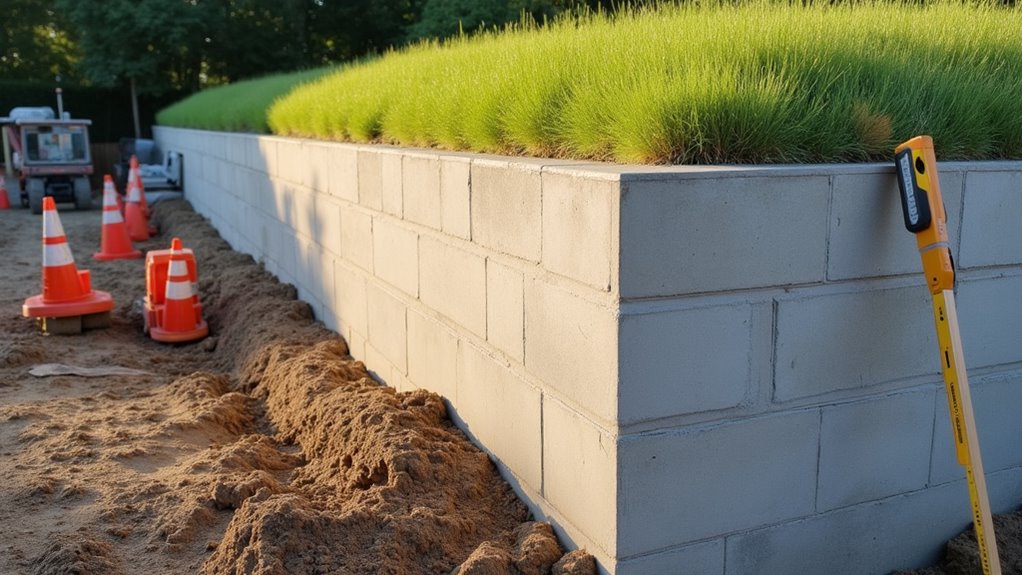You’ll achieve efficient watering with a drip irrigation system that delivers water directly to plant roots through a network of pipes and emitters. The system works by maintaining consistent pressure (15-30 PSI) through regulators and filters, while automated controllers manage precise watering schedules. Your plants receive exactly what they need, reducing water waste by up to 70% compared to traditional methods. Understanding the core components and proper maintenance will enhance your system’s effectiveness.
Components of a Drip Irrigation System

A properly designed drip irrigation system consists of several essential components that work together to deliver water efficiently to your plants’ root zones. You’ll need a water source connection, a backflow preventer to protect your water supply, and a pressure regulator to maintain consistent flow. A filter system prevents debris from clogging your lines, while a main valve controls the overall water flow.
The distribution network includes mainlines, sub-mainlines, and drip tapes that carry water throughout your garden. You’ll find different emitter types to choose from, including built-in and external options, each designed for specific flow rates and plant needs. Controllers and timers allow you to automate your watering schedule, while pressure gauges and flow meters help you monitor system performance and detect potential issues.
Water Distribution and Flow Mechanics

The effective management of your drip irrigation system depends on precise pressure control to guarantee uniform water delivery across all emitters. You’ll need to carefully evaluate drip emitter flow patterns, which can range from point-source to linear distributions, to match your plants’ specific water requirements. When designing your irrigation network, you must consider factors like terrain slope, pipe sizing, and zoning to optimize water distribution while maintaining consistent pressure throughout the system.
Pressure Control and Regulation
Maintaining proper pressure control forms the backbone of efficient drip irrigation performance. Through pressure optimization and flow regulation, you’ll guarantee uniform water distribution across your entire system. By managing pressure effectively, you’ll prevent both overwatering and underwatering while maximizing water-use efficiency.
- Install pressure regulators at your system’s main valve to maintain consistent flow rates and prevent damage to drip emitters
- Monitor pressure gauges regularly to verify they’re operating within manufacturer-specified ranges (typically 15-30 PSI)
- Use pressure-compensating emitters to maintain uniform water delivery despite elevation changes or long lateral runs
- Add automatic pressure relief valves to protect your system from sudden pressure surges that could damage components
Drip Emitter Flow Patterns
Understanding drip emitter flow patterns plays an essential role in achieving ideal water distribution throughout your irrigation system. Different emitter types create distinct wetted zones in the soil, affecting how water reaches your plants’ root systems.
You’ll find that pressure-compensating emitters maintain consistent flow rates regardless of pressure variations, producing uniform circular patterns. Non-compensating emitters, while simpler, may create irregular patterns when pressure fluctuates. Point-source emitters deliver water in a concentrated area, ideal for individual plants, while line-source emitters create continuous strips of moisture along rows.
When selecting emitters, consider your soil type’s infiltration rate. Sandy soils need higher flow rates as water moves downward quickly, while clay soils require lower flow rates to prevent surface pooling and guarantee proper lateral movement.
Network Design and Layout
Proper emitter flow patterns work hand-in-hand with an effectively designed irrigation network to optimize water efficiency. When planning your system’s layout, you’ll need to take into account specific network considerations and layout strategies that guarantee consistent water distribution.
- Position your mainline pipes along the highest point of your garden, allowing gravity to assist water flow and maintain consistent pressure throughout the system.
- Space your lateral lines according to soil type and plant root zones, typically 18-24 inches apart for clay soils and 12-18 inches for sandy soils.
- Install pressure regulators and filters at strategic points to prevent emitter clogging and maintain uniform water distribution.
- Design your zones based on plant water requirements, sun exposure, and soil conditions to create efficient irrigation blocks that you can control independently.
Pressure Regulation and Filtration Methods

Because drip irrigation systems operate with specific pressure requirements, effective regulation and filtration systems serve as the foundation for reliable operation. You’ll need to install pressure regulators to maintain consistent water flow and prevent damage to your irrigation components. Different pressure types include preset, adjustable, and automatic regulators, each suited for specific system demands.
Your filtration systems should match your water source quality and emitter requirements. Install a primary filter to remove large particles, followed by secondary filters for finer contaminants. You’ll want to use screen filters for municipal water, while sand media filters work better for pond or well water. Remember to regularly check your pressure gauges and clean your filters to maintain peak system performance and prevent clogging that could compromise water distribution efficiency.
Installation Steps and Best Practices
Begin your drip irrigation installation by mapping out your garden’s layout and water requirements, ensuring you’ve accounted for plant spacing, terrain variations, and zone divisions. You’ll need to connect the system’s core components – from the water source through the backflow preventer, filter, pressure regulator, and main lines to the emission devices following manufacturer specifications and local codes. Regular maintenance checks of filters, emitters, and pressure readings will keep your system operating at peak efficiency while preventing common issues like clogging and uneven water distribution.
Planning Layout and Design
Before installing a drip irrigation system, creating a detailed layout plan guarantees ideal water distribution and system efficiency. Your site selection should account for terrain slopes, soil type, and existing vegetation. Consider crop suitability when determining emitter placement and water requirements.
- Map your irrigation zones based on plant types, sunlight exposure, and water needs, ensuring even distribution across your surroundings.
- Calculate water pressure requirements and flow rates to determine ideal pipe sizes and emitter quantities.
- Design your mainline layout to minimize pressure loss while maintaining adequate flow to all zones.
- Position filters, pressure regulators, and control valves at strategic points for easy maintenance and system control.
Remember to include shut-off valves at key points and plan for future expansion when sizing your mainlines and sub-mains.
Connecting Main Components Properly
Once you’ve finalized your layout design, connecting the main components of your drip irrigation system requires methodical assembly and attention to detail. Start by attaching your backflow preventer to the water source, followed by the pressure regulator and filter unit. Check component compatibility before proceeding with each connection.
Secure all fittings using appropriate connection techniques: compression fittings for mainlines, barbed connectors for drip tubes, and threaded connections for control valves. You’ll need to guarantee watertight seals by using Teflon tape on threaded components and confirm that each connection is properly tightened. Install pressure-compensating emitters along your drip lines at pre-marked intervals, and anchor the tubing with stakes. Test each section systematically for leaks before covering the lines with mulch.
Maintenance for Optimal Performance
Maintaining your drip irrigation system‘s ideal performance requires a systematic inspection and cleaning schedule throughout the growing season. Regular maintenance guarantees water efficiency and prevents system failures that could damage your plants.
- Perform routine checks of filters and pressure regulators monthly, cleaning or replacing components that show signs of clogging or wear.
- Flush your mainlines and laterals every two months to remove sediment buildup and prevent emitter blockages.
- Monitor emitter output at different points in your system to identify inconsistencies and make necessary adjustments to maintain uniform water distribution.
- Consider system upgrades like automated controllers or soil moisture sensors to optimize water usage and improve irrigation timing.
Remember to document all maintenance activities and system modifications to track performance trends and plan future improvements effectively.
Maintenance and Troubleshooting Guide
Regular inspection and proper maintenance of your drip irrigation system guarantee ideal performance and longevity while preventing water waste. Implement a thorough maintenance schedule and troubleshooting techniques to identify and resolve issues promptly.
| Problem | Cause | Solution |
|---|---|---|
| Uneven Water Flow | Clogged Emitters | Flush Lines/Clean Filters |
| System Leaks | Damaged Components | Replace Faulty Parts |
| Low Pressure | System Blockage | Check Valve/Clear Debris |
| Poor Coverage | Incorrect Spacing | Adjust Emitter Placement |
You’ll need to flush the lines monthly, clean filters bi-weekly, and inspect emitters weekly during peak season. Check system pressure regularly and adjust as needed. Replace damaged components immediately to prevent water waste. Document your maintenance activities to track system performance and identify recurring issues. When troubleshooting, start at the water source and work systematically through the system.
Benefits and Resource Conservation
A well-maintained drip irrigation system delivers significant environmental and economic advantages. Through precise water delivery, you’ll optimize your contribution to sustainable agriculture while minimizing resource waste.
Drip irrigation maximizes agricultural sustainability through efficient water distribution, creating both environmental benefits and resource optimization.
- You’ll reduce water consumption by up to 70% compared to traditional irrigation methods, as water is delivered directly to plant roots with minimal evaporation or runoff
- You’ll lower your energy costs since drip systems operate at lower pressures while maintaining ideal soil moisture levels
- You’ll improve water conservation by preventing weed growth and soil erosion through targeted water application
- You’ll boost crop yields and plant health by maintaining consistent moisture levels and reducing foliar diseases
These benefits make drip irrigation an essential tool for modern farming and gardening practices, promoting both environmental stewardship and operational efficiency.
Design Tips for Maximum Efficiency
When designing your drip irrigation system, careful planning and strategic layout will determine its long-term efficiency. You’ll need to calculate proper drip spacing based on your soil type and root zones, ensuring ideal soil moisture distribution throughout your growing area.
Select emitters that match your crop requirements, considering factors like flow rate and pressure compensation. You’ll want to group plants with similar water needs in the same irrigation zones. Install pressure regulators and filters to maintain consistent water delivery and prevent clogging.
Plan for system scalability by incorporating mainlines that can accommodate future expansion. Monitor efficiency metrics through soil moisture sensors and flow meters to fine-tune your setup. Position your control valves in accessible locations for easy maintenance and adjust your system’s operating schedule based on seasonal changes and plant growth stages.
Frequently Asked Questions
Can Drip Irrigation Systems Be Used for Indoor Houseplants?
Yes, you can definitely use drip irrigation for your indoor plants! You’ll find it’s an excellent way to maintain consistent watering efficiency while saving time and effort. Set up a small-scale system using micro-tubing, emitters, and a timer connected to your water source. It’s perfect for multiple houseplants, ensuring each one receives precise water amounts. You’ll reduce water waste and maintain ideal moisture levels, especially when you’re away.
What Happens to Drip Irrigation Systems During Freezing Winter Temperatures?
You’ll need to protect your drip irrigation system from frozen pipes during winter to prevent damage. Start by draining all water from the lines and removing end caps to guarantee complete emptying. For winter maintenance, disconnect the main valve, remove filters and pressure regulators, and store them indoors. You can also insulate exposed pipes and valves with foam covers. If you’re in a severe climate, consider using self-draining valves for added protection.
How Long Does a Typical Drip Irrigation System Last Before Replacement?
You’ll typically get 10-15 years from your drip irrigation system if you maintain it properly. System maintenance plays an essential role in longevity – regular filter cleaning, pressure checks, and leak repairs can extend its life considerably. Replacement factors include UV damage to exposed tubing, mineral buildup in emitters, and physical damage from gardening tools. You’ll need to replace individual components periodically, but with proper care, the main infrastructure can last well beyond a decade.
Are There Special Fertilizers Designed Specifically for Drip Irrigation Systems?
Yes, you’ll find specially formulated water-soluble fertilizers designed for drip irrigation systems. These solutions are completely dissolved to prevent clogging and guarantee efficient nutrient absorption through your drip lines. Look for products labeled as “fertigation-compatible” or “drip-system fertilizers.” Common types include liquid concentrates and water-soluble granules containing balanced NPK ratios. You’ll want to avoid standard granular fertilizers, as they can block emitters and reduce system efficiency.
Can Drip Irrigation Systems Be Powered by Solar Energy?
Yes, you can power your drip irrigation system using solar panels, making it an energy-efficient and sustainable solution. You’ll need to connect solar panels to a controller and pump system, which can operate without grid electricity. This setup’s particularly valuable for remote locations or if you’re aiming to reduce utility costs. Many modern solar-powered systems even include smart controls that’ll optimize water usage based on real-time conditions and scheduling needs.



